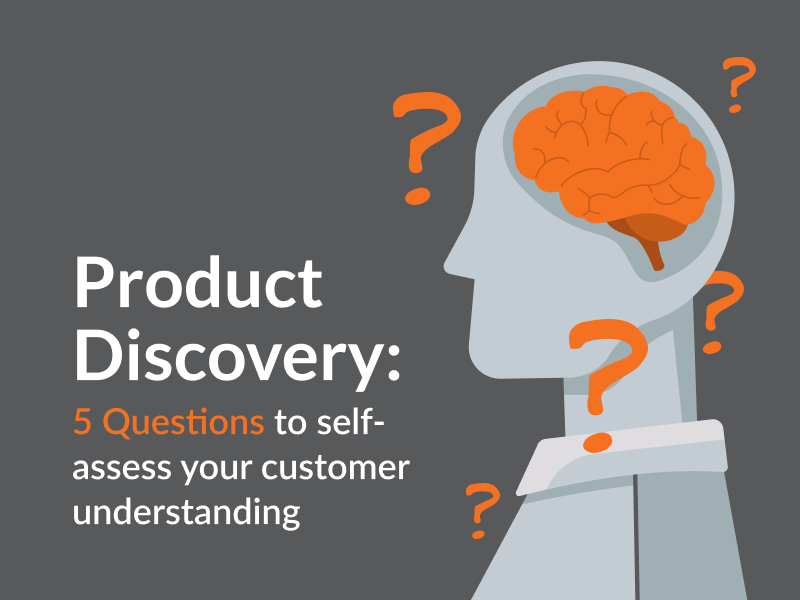
When you’re trying to understand your customer during product discovery it’s easy to get caught up in frameworks, methodologies, checklists and processes but ultimately there are some big fundamental questions you need to keep focused on.
Understanding your customer is a key part of discovery and ultimately a key part of product success or failure. It is usually where the most risk lies, building things right is usually easier than building the right thing for the right customer.
There are 5 big yet simple fundamental questions that you can use to self assess how well you have understood your customer.
Let’s look at each of them, what they are seeking to understand and why they matter.
“Get closer to your customer than ever before. So close you know what they want before they realise it themselves” – Steve Jobs
Understanding Your Customer
The first port of call is to get an overall understanding of who you are solving problems / sell your solution to. We need an answer to the following:
Q1: What Are Your Customers’ Needs, Goals and Pain Points?
Without knowing the answer to this you risk not being able to find anyone willing to buy your product. A product exists to solve needs and provide a customer a benefit/capability. You need to be sure there’s customers who care about this benefit/capability.
Symptoms of this are:
- Poor acquisition of customers
- No product market fit
- Difficult to articulate value proposition
- Customer’s/User’s that expressly say they confused by the value of your product
Q2: What Are Your Customers’ Behaviours, Attitudes and Beliefs?
Understanding these aspects let you decide how to structure your sales channels and in some cases influence the very mechanism you want to use to deliver value.
Example: If you know your customer doesn’t use facebook, you certainly wouldn’t use facebook to try and acquire them nor would you bother building facebook authentication as a feature.
Symptoms of this are:
- Sales Channels not attracting the right types of customers
- Usability problems
Q3: What Are Your Customer Segments?
Groups of customers are not always uniform. Failing to recognise significant differences in the underpinning needs of different segments can lead one to building confusing or weak value propositions. It’s typically far better to solve one clear pain point for a subset of customers than to weakly address two pain points.
Symptoms of this are:
- High cost of acquisition
- Low retention rate
- Roadmap radically changing everytime someone talks to a customer who looks the same on paper as your other customers
- Attempting to serve both large enterprise customers and small businesses with the same offering
Q4: What Are Your Customers Currently Paying to Solve This Problem?
Failing to understand how much a customer wants to pay will critically affect the financial viability of your product.
You may ask why does it matter how they are solving their pain points currently? Primarily you need to know this because you need to overcome the inertia of them not moving onto your product. Understanding what they currently do is critical in this.
Secondly, understanding their current approach lets you understand what they’re spending on it. Your product has to be cheaper than their current approach, or superior in dimensions that the customer cares about.
Example: imagine trying to convince a customer to use a new wireless broadband internet connection and you know the customer currently uses a wired broadband connection. You now know that their problem is at least semi solved and you know what they pay. Your new wireless product either has to be cheaper than the wired solution or offer some benefit the customer values more than the price difference (no cables).
Symptom of this are:
- High cost of acquisition due to inability to migrate from old solution
- Low feature usage in the features you hypothesised customers wanted.
Q5: How Sure Are You About Any Assumptions You’ve Made?
This one is less about a question you ask your customers but an important introspective question.
Another way of asking it is: Do we have data to back up any of our assumptions?
Assumptions and anecdotes are great starting points but knowledge of your customer cannot remain in the land of theory and untested hypotheses.
When you release your product you implicitly are testing your assumed knowledge of your customer. When assumption differs from reality, pain will follow. For all intents and purposes, failure to have data backing up the answers to one of the above questions should be treated as if you do not have an answer at all.
Symptom of this are:
- Unable to explain customer behaviour when it differs from expectation.
- Assumptions often being proved false
Filling the Void
If you’ve got a gap in understanding your customers then the solution is to double down on customer focus in your discovery process. Without knowing the specifics of your context one can only safely say it involves talking to your customers.
Some of the other activities to consider is the following:
- Customer interviews and surveys
- Build and validate personas
- Build an empathy map
- Map out a customer value proposition canvas
- Uncover the customer’s jobs to be done
- Map out the buying journey
You can find a complete checklist for knowing your customer here. It’s a good read to understand in more detail what some of the above terms mean.
It’s also worth noting that there are Discovery concerns worthy of consideration outside of the domain of the customer. Run through our Discovery Self Assessment to find out exactly what you need to do next.